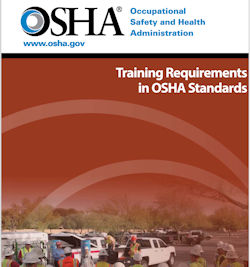Categories of Education
First Things First
As we discussed in the previous module, the three strategies in the total safety education KSA model are:
- Instruction: Teaches learners about safety through instruction to gain knowledge (K).
- Training: Applies the knowledge gained in hands-on training to develop the initial skills (S) required for a task.
- Experience: Applies these skills on the job to gain experience and improve abilities (A), helping the learner to excel.
The knowledge and skills that employees must gain is summarized in OSHA Publication 2254, Training Requirements in OSHA Standards and Training Guidelines which discusses more than 100 OSHA safety and health standards that require some form of instruction and training.
Some safety instruction and all safety training should include evaluations. This ensures that employees have the necessary knowledge, skills, and abilities (KSAs) to work safely.
How to Impress OSHA
Let's consider this from a different perspective. When OSHA inspectors arrive for a safety inspection or, in a more serious situation, an accident investigation, they will likely ask employees about their jobs and observe them working. While it might seem they are just looking at objects in the workplace, they are actually paying attention to everything. It's important to remember that everything they see and hear gives them information about the company.
One of the first things OSHA inspectors will check, even before they inspect the work area, is the safety training program. They will want to review your training records. They prioritize training because experience has shown that if the safety training program doesn't meet basic standards, it's unlikely the company is fully complying with OSHA requirements. OSHA compliance officers base their evaluations on the education they receive:
- Employee Knowledge: If inspectors ask employees questions and only receive shrugs or 'I don’t know' as answers, they are likely to scrutinize the workplace conditions more closely.
- Employee Competence: On the other hand, if employees answer safety questions knowledgeably and demonstrate skill, this impresses the inspectors and positively influences the overall inspection.
Knowledge Check Choose the best answer for the question.
2-1. What are the three strategies in the total safety (KSA) learning process?
You forgot to answer the question!

